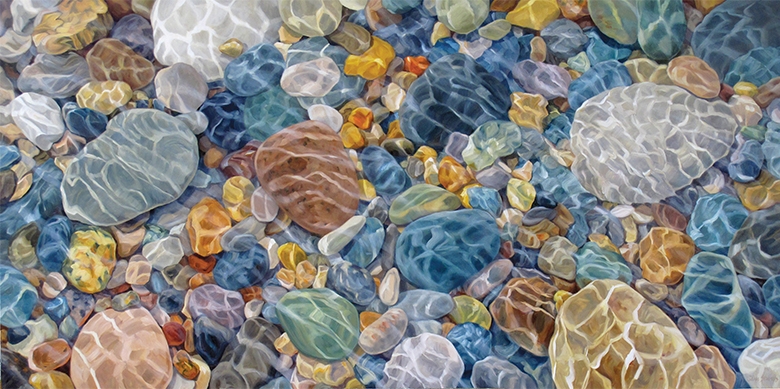A painting is never really done for Jean Stevens.
The Kalamazoo-based artist said she’ll sometimes take down a painting hanging on the wall of her Park Trades Center studio and add a few more brush strokes of color to it.
“I love starting, but finishing is more difficult for me because then the possibilities are gone,” Stevens said. “I’m trying more and more to jump out while it’s still alive. When you’re casting about with your brush and it’s not going anywhere, I know it’s done.
“(But later), I see things I could do to them and I take them out of the frame and work on them. It happens a lot.”
While a student at Western Michigan University where she earned a master of fine arts in painting in 1997, Stevens worked in a variety of subject and media, but a vacation started her on a trajectory to become a well-known painter of nature.
“I was looking out at the water from a boat and I started thinking about what I wanted to paint and I thought, ‘Why not this?’” she said. “Water, clouds, branches, there are all of these patterns in nature.”
Stevens said she tends to focus in on elements of nature that she finds meditative or hypnotic, or scenes where she finds a sense of wonder.
“I’m an environmentalist, and that is what really inspires and informs my artwork,” Stevens said. “Whether I’m in the Tongass National Forest in Alaska, the high desert in New Mexico, the coral reefs in the Caribbean, or Michigan woods and lakes.”
Stevens said she paints “about the environment,” because it’s deeper than just painting something in nature that she finds beautiful. Her painting titled Vanishing Hawksbill is about more than being in the water with a sea turtle and watching it swim away.
“It was magical to me, but also sad, because they’re severely endangered, vanishing from the face of the earth — and I’m someone who feels that when they’re gone, the world will be a much poorer place,” Stevens said. “It’s the same with monarchs, orangutans and elephants, and all the other species who are disappearing every day along with their habitats. What people are doing to the planet is the biggest issue facing them, but they seem oblivious. We belong to the earth, not the other way around.”
Left: Between Worlds. Middle: Jean Stevens. Right: Vanishing Hawksbill.
While the untrained eye will likely not notice, Stevens mixes with just six colors in her paintings, something she taught herself. Her technique has continued to evolve. She moved to working with acrylic on canvas three years ago and started using painting knives one year later.
Her smaller paintings tend to present a larger view of what she perceives while her larger works offer a more up-close and personal view.
At any given time, she is working on four or five paintings. She said she tries to be in her studio eight hours each day.
“Really paying attention and being focused takes a lot out of you,” Stevens said. “It’s a big challenge to be there with (a painting) and to not judge it.
“Right now, I’m feeling like the whole focus is being in the moment and learning to let go. I’m working on being in the now and interpreting more loosely and trying for the feel of what it was like to be somewhere.”
Before retiring, Stevens had a full time job that provided her with a steady income to cover the cost of studio rental, supplies and exhibits. For her, that job was as a museum exhibition designer with the Kalamazoo Valley Museum and its predecessor, the Kalamazoo Public Museum. The job involved plenty of artistic tasks, as she would put together shows with framing, writing and graphics.
Perhaps more important than the steady income that her job provided was the freedom to paint for herself and focus on subjects that mattered to her.
“I still feel like there’s so much I can do to develop my painting,” Stevens said. “In the last 20 years, the subject matter that I’m interested in almost depends on it not being about me. I need to get myself out to see what I want to come out and not be so controlling.”
She calls her paintings accessible and has her share of collectors. Her work is also on display at businesses and organizations such as WMU, the Van Andel Institute, Kalsec and St. Thomas More Church in Kalamazoo. Lately, she said she’s been turning down requests for commissioned pieces because she has so many ideas of her own.
“The important relationship is what’s going on between you and the piece in the moment,” Stevens said. “It’s about trying more and more to be there and less about what fits in and who’s going to look at it. You and (the painting) reach some kind of agreement when it’s complete.”
Find Stevens' work at jeanstevensart.com.





